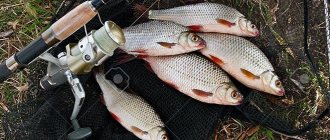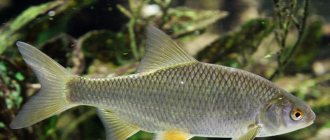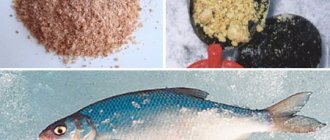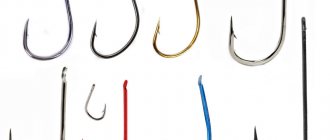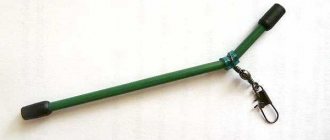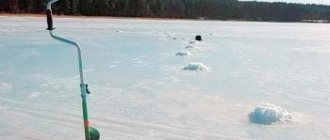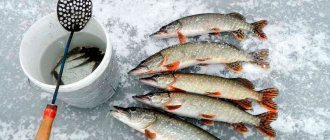Roach, perch, and bream are widely distributed in rivers and lakes. Of these, roach is popular and interesting for fishing. It is especially interesting to catch it in the summer, when it is well-fed and therefore as careful as a bream.
At this time of year, it is easiest to catch it away from the coast. Which is possible if you have special gear that allows you to send the bait over a long distance, or if you have a boat to sail from the shore.
If difficulties rarely arise with choosing a boat, then the question regularly arises about gear that allows you to cast bait as far as possible from the shore: which one is best to choose.
Where to look for roach in summer
Although roach is one of the most common fish in our waters, it is not easy to catch them in large numbers. Only experienced fishermen who know the secrets of its behavior and food preferences succeed in this. They catch roach with a float rod and feeder.
If in the spring roaches are found in any part of the reservoir, then in the summer things are different. With the appearance of underwater vegetation, it moves to places with the largest concentrations of them. On bodies of water with a current it is:
- Backwaters overgrown with water lilies and reeds.
- Shallows.
- Bridge supports.
- Channel edges.
She prefers areas with a hard bottom, be it sand or stones. A very promising place is the transition from a hard bottom to a soft one, for example, from shell rock to silt.
“On small rivers, roaches like to stand in the flooded rhizomes of trees, near bushes hanging over the water. Here she has both shelter and a good food supply.”
In lakes, ponds and reservoirs, small specimens stay close to the shore, in grassy shallow water, while large specimens choose deeper and cleaner places. If there is no grass, then roaches should be looked for at the exits of holes, near snags, trees fallen into the water.
Roach fishing in May
It is possible that roach spawning may occur in May, so we will be guided by the weather.
Roach practically does not need rest after mating games. Therefore, the bite stabilizes almost immediately. As a rule, from mid-May the roach completely switches to summer mode.
Here she stays near the reed thickets, hiding from a strong current, if there is one. On lakes and reservoirs, depending on the depth, it can stand both in the coastal zone and at some distance. But as a rule, up to 15 meters - no further.
Here are a few favorite places for roaches in spring in May:
- Reed edge.
- The shell is at the bottom, where food is retained well.
- Visits haunted places, but does not stay for long. Risk of a lurking predator.
- Small elevations in the relief, the so-called tables or navels.
- Occasionally, especially large roaches move to the middle of the edge. Can stand in the water column.
- Bays with a gentle current.
Tackle
Despite its abundance, roach is a cautious fish and is difficult to catch with rough gear.
If in the spring it is still forgivable to use thick fishing lines, then in the summer such a trick will not work. A typical roach bite looks peculiar - the float constantly trembles and only after a while moves to the side or sinks. So the roach tries the bait and immediately spits it out, then tastes it again and spits it out again. And only after making sure that the proposed nozzle is safe, does he swallow it.
Roach tackle should be as light and elegant as possible. What to fish with depends on local conditions and the personal preferences of the fisherman. The following types of rods are used:
Bolognese fishing rod. The most versatile tackle. It is used to catch fish both near the shore and at a decent distance from it. The average length of rods is from 5 to 7 m.
When fishing in line, when you have to keep the tackle suspended all the time, it is better to choose a carbon fiber rod, as it is much lighter than fiberglass.
Fly rod. This is a tackle with a blind snap. The length of the main line is equal to or slightly longer than the length of the rod blank. They fish with a fly rod near the shore or from a boat. The average length is from 5 to 7 m.
Plug rod. Here, too, only blind equipment is used. Due to the long blank, you can fish with a plug at a considerable distance and use very thin fishing lines. Length – more than 8 m.
Match rod. Used in places where a regular lap dog cannot be reached. The equipment is most often sliding. The float has additional weight in the form of replaceable washers. This allows you to make long casts. The main place of application is lakes and reservoirs.
Feeder. If the fishing point is far from the shore, then there is no alternative to a feeder. Of course, you can fish from a boat, but not every angler has one. Roach is caught with a feeder on large rivers and reservoirs.
The main gear for catching summer roach is a float rod. The equipment must also match the fishing rod:
- The main line is 0.16–0.18 mm in diameter.
- Leash 0.10–0.14 mm, length 20–30 cm.
- Hooks size 10–16 according to international numbering.
- Lightweight float with a load of 1–2.5 g.
When fishing in a current, you need to choose spherical-shaped floats, and when fishing in still water, spindle-shaped ones.
Features of catching roach on a float
What to use to catch roach? It all depends on the time of year. Spring roach prefers bloodworms and dung worms. It is during this time of the spring run that the largest specimens of roach are caught. In the current, they use donks, but in oxbow lakes and backwaters among the bushes of the common grass, a simple float rod works very well. The roach rises along the riverbed to spawn; this is its daily route. But in the evenings, tired fish leave the current into the quiet waters of the oxbow lakes, warmed by the sun during the day, where at times they very greedily bite on a float rod with a worm on the hook. No bait is even required here. The fish are fed by worms and insects crawling out of shelters flooded with melt water. Therefore, the roach boldly approaches the shores and confidently grabs the bait.
Roaches take to the float rod in early spring. After spawning, its bite becomes active again. Only now, in May-early June, you can’t tempt her with a worm, at least not everywhere she rushes at the worm. Now her favorite baits are maggots, semolina, semolina, barley, corn, and rye bread.
In mid-summer, the roach bite becomes capricious and periodic. She stays in the grass. At this time, the nozzle is lowered into the windows among the water lilies. Here the roach is caught on the hook along with the rudd. From time to time, do-it-yourself bait for roaches, made from corn flour, breadcrumbs, ground biscuits, powdered milk, semolina, ground seeds, is thrown into the gaps among the grass, or ready-made bait is used, for example, “Roach. Black", "Sensas", but sometimes a pinch of small maggots mixed with bran replaces all the most expensive baits. Maggot is a very active live bait, and bran creates a cloud of food turbidity, which is used by all “white” fish.
A roach fishing rod is used in such places with “blind” equipment, the so-called fly rod. Lightweight and durable, it allows you to accurately place the nozzle in the window among the grass. Early morning in summer is the best time to catch roach. It is at dawn that the largest fish are caught. Moreover, sometimes a lump of mashed rye bread tempts roaches more than corn and maggots.
Closer to autumn, roaches again begin to hunt for worms, and closer to freeze-up - for bloodworms. Maggot remains a universal bait almost all season long.
What to fish with
What kind of jigs are there for catching roach in winter (photo)
The roach bite is often capricious, and it is impossible to say with certainty what it will be caught on today. Therefore, the angler must have a variety of baits of both animal and plant origin. Since the beginning of summer, the roach's diet has gradually changed. She continues to be caught using animal bait:
- maggot,
- bloodworm,
- caddisfly,
- worm.
But already from mid-June, vegetable baits become no less effective:
- wheat,
- pearl barley,
- corn,
- peas,
- filamentous algae or "greens"
- semolina chatter,
- bread crumb,
- dough.
Lure
In summer, unlike spring, fishing without bait gives modest results. Store-bought mixtures are more convenient to use, they do not need to be prepared, you just need to add water and bring to the desired viscosity.
“Without the necessary knowledge, you should not mix bait from different manufacturers, since their composition is not the same and problems may arise with combining odors. As a result, the combined bait can easily scare away the fish.”
But bait and aromatic components from the same company, but from different lines, as a rule, work well together.
An important feature of bait is its color. It should be close to the color of the bottom of the reservoir: usually it is brown, gray, gray-black. Too bright shades scare away roaches, since against their background it becomes noticeable to a predator.
The advantage of homemade bait is that you can choose exactly the ingredients that the local roach loves. This mixture sometimes attracts fish better than commercial bait consisting of more neutral components.
It’s not difficult to make roach bait yourself: it should be based on breadcrumbs, with the addition of sunflower and hemp seeds. But, as mentioned above, roaches also love other odors that are unique to a particular body of water. Proven roach flavors:
- Hemp.
- Coriander.
- Anise.
- Chocolate.
- Corn.
In the summer, a combination of loose bait for roaches and vegetable components: steamed wheat or pearl barley, corn, has worked well. In June, roaches are still not indifferent to the animal components of bait - bloodworms and maggots.
The main part of the bait should be “dusty” components, which strongly attract roaches and do not saturate the fish. You need to be careful with flavorings and add them in small quantities. In warm summer water, odors quickly spread throughout the reservoir.
“When fishing in a strong current, you need to add earth or clay to the bait. Thanks to the ballast, the mixture sinks to the bottom faster and is washed out longer.”
The bait mixture should be of medium viscosity and form a trail when lowered to the bottom. Too viscous bait will not produce such a trail, so it is better to under-moisten the mixture than to over-moisten it. It is recommended to add water from the reservoir in which fishing is carried out.
June
Catching roach in June with a float rod is the most common method among anglers. The depth in favorite roach places rarely exceeds 3–4 meters and this tackle is well suited for such conditions.
For wire fishing, select a more or less flat section of the bottom and throw the tackle upstream. The bait moved by the current is very attractive to roach.
If you fish with wheat, pearl barley or peas, you can feed them with the same bait, without using a loose mixture. The baited hook should be held slightly higher from the bottom.
In reservoirs where there is no vegetation, usually these are quarries and lakes, roaches are caught with a feeder and areas with a difference in depth are chosen for this. The tackle should be light, sensitive light or medium class feeder rods are suitable, and the weight of the cast feeder rarely exceeds 40 g.
Having found a promising place, it should be fed. For starter feeding, 5-6 balls the size of a medium orange are enough. After catching 3-4 specimens or every 20-30 minutes, you need to throw in a ball of bait the size of a walnut.
River fishing for roach using filamentous algae or “greens” is very productive. The roach bites on this bait only where greens are included in its usual diet. They fish by wire in areas with a rocky bottom and snags – that’s where the “green stuff” usually grows. The best fishing time is early morning and evening. But there are also exceptions. In windy or cloudy weather, the peak bite may occur in the middle of the day.
“When fishing on greens, feeding is not necessary, because filamentous algae already grow in abundance on the bottom.”
Zelenka is mined in shallow areas of the river. The depth at the fishing spot on average does not exceed 1.5–2 meters.
The tackle is a regular Bolognese fishing rod with a 2-3 gram float. The weight of the tackle is evenly distributed along the entire length so that the hook with bait sinks smoothly into the water column. The nozzle is held 5–10 cm above the bottom, holding it periodically.
The greens are planted as follows:
- Take a long strand of greenery (20–30 cm) and fold it in half.
- We make a double noose loop from the greenery.
- We put a loop on the hook and carefully tighten it.
- We leave a small 5-centimeter tail, and tear off the rest.
Roach baits in summer
For the summer fishing period, roach prefers to eat:
- Aquatic vegetation.
- Silkman.
- Worms, bloodworms, all kinds of larvae.
- Caterpillars, bugs, various insects caught in the water.
It is not recommended to immediately use caught worms as bait. They need to be placed in a box of moss for several hours to clear the soil. To give such a nozzle a pleasant aroma, you can put mint or thyme leaves (natural attractants) in the box.
Of course, the most proven baits for roaches are aquatic organisms. To get them out, you can use a rake with a long handle. This device is good at removing algae from the water where these insects live. Among all living creatures, the mayfly larva is considered the most sought after. Caddisfly and dragonfly larvae work well.
Plant attachments:
- Steamed grains of wheat, oats.
- Milk grains of wheat, oats.
- Steamed rolled oats flakes.
- Semolina attachment. The semolina is poured into boiling water in small portions, and with constant stirring, bring it to the desired consistency. After removing the container with porridge from the heat, you need to cool it. Afterwards, knead the semolina with 2-3 drops of sunflower oil with your hands until a plastic mass forms.
- Scrambled meat made from chicken egg white and rye flour. All components are mixed well until a viscous mass is formed, which is wound onto a hook using a regular match.
July
The water has already warmed up in July, and roaches can be caught even at night. At dusk, she approaches the shore, where she is caught with a fishing rod and a float equipped with a “firefly”.
The best roach weather is stable, without pressure drops and precipitation. After prolonged rains the bite gets worse.
Roach responds well to bait. For these purposes, on large rivers such as the Oka and Volga, fishermen build fences and successfully fish from them throughout the summer. A fence placed across a river creates a backwater. With daily feeding of the point, the fish get used to gathering at the “set table”, and the fisherman has large and stable catches.
In the July heat, on lakes and ponds, large roach do not stand at the very bottom, but rise higher, into layers with cooler water, into the so-called thermocline zones. Here it is interesting to catch roach using a bombard. Although this tackle is not as popular as a regular float rod, it is no less effective.
In its design, it is similar to a float, only the float here is loaded and elongated. It is called “sbirulino” or bombarda and there are different types:
- Floating – for fishing in shallow water (up to 1 meter).
- Slow sinking – for fishing at a depth of 1 to 2 meters.
- Fast sinking - for fishing at a depth of more than 2 meters.
Any fishing rod is suitable - a feeder rod, a Bolognese rod. The optimal length of the fishing rod is from 4 to 5 m. Long leashes are placed on the roach - from 100 to 300 cm.
The attachment is a fly fishing fly, maggot, dough. Wiring is slow and steady. In addition to roach, the catch often includes perch, carp, and pike.
Roach fishing in March
In early spring, in March, in some regions the water bodies were not yet free of ice. This article will talk about fishing for roach in liquid water.
For lovers of winter fishing, a separate material has been prepared - “catching roach on the last ice.”
Despite the fact that on the last ice the roach adheres to the coastline and shallow water areas, immediately after the ice melts it moves a little further away.
At temperatures up to 8 degrees, the roach stands between the center of the channel and the edge, occasionally approaching the border of that very edge.
On deep water lakes, reservoirs and river floods, spring roach stands a little further away, the distance varies depending on the total depth. Approximately about 20-40 meters.
It is quite difficult to give general information that will be useful to all Russian-speaking fishermen. Still, this is not one country, and Russia is big - different weather conditions, different living conditions... Therefore, it is more correct to focus on the reports of fishermen in your region. For this, we have created a special section with a map and reports exclusively on roach, here it is - “where to catch roach”.
You can not only analyze and study, but also help others by leaving your report. Here - “add report”.
